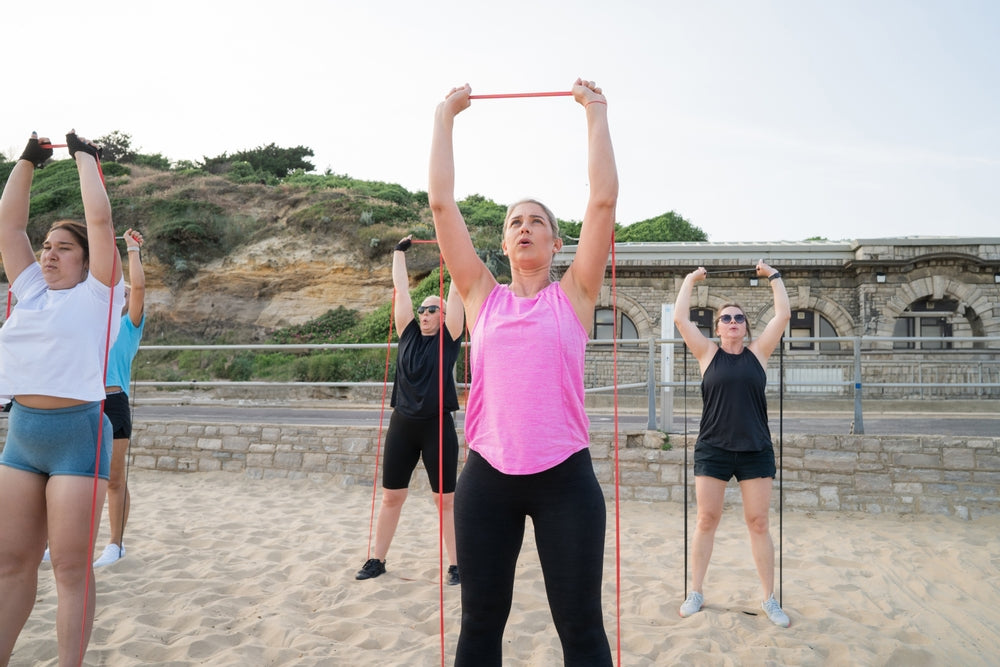Mastering Stronger Shoulders with Resistance Bands
Stronger Shoulders, Anywhere, Anytime💪🔥
BY DRAPER'S STRENGTH
UPDATED: SEPTEMBER 19, 2023

Table of Contents
What are Resistance Bands?
Anatomy of the Shoulders
Choosing the Right Resistance Band
Shoulder Exercises with Resistance Bands
Sample Workout Routines
Tips for Safe and Effective Workouts
Potential Users
Conclusion
References and Further Readings
Welcome to our comprehensive guide on using resistance bands to build stronger, more stable shoulders. Shoulder strength and stability are crucial for various daily activities, from lifting objects to maintaining good posture. Whether you're a fitness enthusiast looking to enhance your shoulder workouts or someone seeking rehabilitation or low-impact exercises, resistance bands can be your best companion on your journey to healthier shoulders.
In this guide, we will take you through the fundamentals of resistance bands, dive into shoulder anatomy, provide tips for selecting the right resistance band, and introduce you to a variety of shoulder exercises you can perform with these versatile tools. We'll also offer sample workout routines and safety precautions to ensure that your resistance band shoulder workouts are not only effective but also safe.
What Are Resistance Bands?
Resistance bands are elastic exercise tools made from latex or similar materials. They come in various forms, including loop bands, pull up bands, and powerlifting bands. Unlike traditional weights, resistance bands create resistance throughout the entire range of motion, making them highly effective for strength training.
Resistance bands work on the principle of resistance, which means they oppose the force applied to them. When you stretch a resistance band, it provides resistance in the opposite direction, creating tension in your muscles. This tension challenges your muscles and stimulates them to grow stronger over time.
Advantages of Using Resistance Bands Over Traditional Weights
Versatility: Resistance bands can be used for a wide range of exercises, making them suitable for various muscle groups and fitness levels.
Portability: They are lightweight and compact, making them ideal for home workouts, travel, or workouts on the go.
Safety: Resistance bands reduce the risk of joint strain and injury, as they provide a smoother resistance curve compared to free weights.
Affordability: They are cost-effective compared to expensive gym equipment, and they can last a long time with proper care.
Adaptability: You can easily adjust the resistance level by using different bands or changing the way you use them, ensuring continuous progress in your workouts.

Anatomy of the Shoulders
Before we start with the exercises, it's essential to understand the basics of shoulder anatomy. The shoulder is a complex joint consisting of three major bones: the humerus (upper arm bone), the clavicle (collarbone), and the scapula (shoulder blade). This joint's complexity allows for a wide range of motion but also makes it susceptible to injuries if not properly strengthened and stabilized.
Balanced shoulder muscles are crucial for shoulder joint stability and function. The shoulder muscles, including the deltoids, rotator cuff, and trapezius, work together to provide support and mobility. Neglecting any of these muscle groups can lead to imbalances, which may result in pain, reduced mobility, or even injuries.

Choosing the Right Resistance Band
Resistance Level: Bands come in various resistance levels, typically ranging from light to heavy. Choose a resistance level that challenges your muscles but allows you to complete the exercises with proper form.
Band Type: Resistance bands come in different forms, including loop bands, pull up bands, and powerlifting bands. The type you choose depends on your personal preferences and the exercises you plan to perform.
Tips for Purchasing High-Quality Bands
Material Quality: Look for bands made of durable latex or similar materials. High-quality bands are less likely to snap or break during use.
Handle Grip: If you opt for resistance bands with handles, check the quality of the handles for comfort and durability.
Resistance Band Sets: Band sets often include bands with varying resistance levels, offering versatility in your workouts.
Shoulder Exercises with Resistance Bands
Shoulder Press
- Begin in a standing or seated position with one end of the band under your feet.
- Hold the band at shoulder height, elbows bent.
- Press the band overhead, extending your arms fully.
- Lower the band back to shoulder height and repeat.

Lateral Raises
- Stand on the center of the band with feet hip-width apart.
- Hold the band handles at your sides with palms facing your body.
- Raise your arms to shoulder height, keeping them straight.
- Lower your arms back to your sides and repeat.

Front Raises
- Stand on the center of the band with feet hip-width apart.
- Hold the band handles in front of your thighs with palms facing your body.
- Raise your arms to shoulder height, keeping them straight.
- Lower your arms back to your thighs and repeat.

Rear Deltoid Flyes
- Secure the band to a sturdy anchor at waist height.
- Stand facing away from the anchor and hold the band handles in each hand.
- Bend forward at the hips with a slight bend in your knees.
- Extend your arms outward and slightly upward to the sides, squeezing your shoulder blades together.
- Return to the starting position and repeat.

Rotator Cuff Exercises
- Secure the band to a fixed point at waist height.
- Stand sideways to the anchor and hold the band handle with the arm closest to the anchor.
- Keep your elbow at a 90-degree angle and your upper arm against your side.
- Rotate your forearm outward against the resistance of the band.
- Return to the starting position and repeat.

Sample Workout Routines
Beginner Routine
- Lateral Raises: 3 sets of 10-12 reps
- Front Raises: 3 sets of 10-12 reps
- Rotator Cuff Exercises: 2 sets of 12-15 reps
Intermediate Routine
- Shoulder Press: 4 sets of 8-10 reps
- Lateral Raises: 4 sets of 10-12 reps
- Rear Deltoid Flyes: 3 sets of 10-12 reps
- Rotator Cuff Exercises: 3 sets of 12-15 reps
Advanced Routine
- Shoulder Press: 5 sets of 6-8 reps
- Lateral Raises: 5 sets of 8-10 reps
- Front Raises: 4 sets of 10-12 reps
- Rear Deltoid Flyes: 4 sets of 10-12 reps
- Rotator Cuff Exercises: 4 sets of 12-15 reps
Remember to warm up before your workout and cool down afterward to prevent injuries and promote flexibility. Hydration and proper nutrition also play essential roles in your shoulder workout success.
Tips for Safe and Effective Workouts
Common Mistakes to Avoid
Using improper form: Ensure proper posture and technique for each exercise.
Using too much or too little resistance: Choose a band that challenges you without compromising form.
Neglecting warm-up and cool-down: Always warm up with dynamic stretches and cool down with static stretches.
Safety Precaution: Regularly inspect your resistance bands for wear and tear. Start with lighter resistance bands if you're new to these exercises. If you experience pain or discomfort during a workout, stop immediately.Potential Users
Fitness Enthusiasts: If you're looking to add variety to your shoulder workouts or challenge yourself further, resistance bands are an excellent choice.
Rehabilitation Patients: Resistance bands are often recommended by physical therapists to aid in the recovery of shoulder injuries or surgeries. They provide controlled resistance for gradual rehabilitation.
Seniors: For older adults, maintaining shoulder strength and mobility is essential for daily activities. Resistance bands offer a gentle way to achieve this without excessive strain.
Athletes: Athletes in various sports, including baseball, swimming, and basketball, can benefit from resistance band exercises to enhance shoulder strength and stability, which can improve performance and reduce the risk of injuries.
Home Workout Enthusiasts: Resistance bands are perfect for those who prefer working out at home due to convenience, affordability, and limited space.
Travelers: If you're frequently on the go, resistance bands are lightweight and easily portable, allowing you to maintain your workout routine wherever you are.

Conclusion
In conclusion, shoulder strength and stability are vital for overall well-being and daily activities. Resistance bands provide a versatile, accessible, and effective way to build and maintain shoulder muscles. Whether you're a fitness enthusiast, an athlete, or someone recovering from an injury, resistance band shoulder exercises can be tailored to your needs.
Remember to start with the basics, understand shoulder anatomy, choose the right resistance bands, and perform exercises with proper form. Safety and gradual progression are key to a successful shoulder workout routine.
If you're looking to elevate your shoulder workouts, consider giving Draper's Strength Resistance Bands a try. They provide a selection of top-notch products, including single bands for customizable resistance, band sets for versatility in exercises, and premium accessories such as band handles and door anchors to enhance your workouts. Plus, you'll gain access to a valuable workout guide to help you make the most of your resistance band training. Strengthen and stabilize your shoulders by exploring their offerings today!
References and Further Readings
Clark, M. A., Lucett, S. C., & Sutton, B. G. (2018). NASM essentials of personal fitness training. Jones & Bartlett Learning.
Meneghel, J., Nascimento, L. R., & Araújo, R. C. (2015). Effects of elastic resistance exercise on muscle strength and functional performance in healthy adults: a systematic review and meta-analysis. Journal of Strength and Conditioning Research, 29(3), 690-706.
Sim, A. S., & Dawson, B. T. (2012). Land-based resistance training practices of elite swimming strength and conditioning coaches. The Journal of Strength & Conditioning Research, 26(8), 2123-2136.



